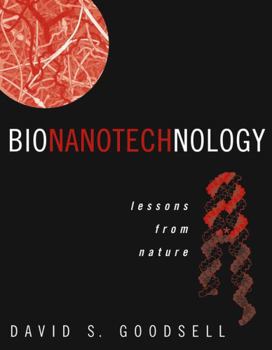Bionanotechnology: Lessons from Nature
Discussions of the basic structural, nanotechnology, and system engineering principles, as well as an introductory overview of essential concepts and methods in biotechnology, will be included. Text is presented side-by-side with extensive use of high-quality illustrations prepared using cutting edge computer graphics techniques. Includes numerous examples, such applications in genetic engineering. Represents the only available introduction and overview...
Format:Hardcover
Language:English
ISBN:047141719X
ISBN13:9780471417194
Release Date:January 2004
Publisher:Wiley-Liss
Length:350 Pages
Weight:0.65 lbs.
Dimensions:0.9" x 7.5" x 9.4"
Customer Reviews
4 ratings
An informative text
Published by Thriftbooks.com User , 17 years ago
This book gave an intriguing instight into the developing field of nanotechnology. Its in-depth explanations of the field and its many aspects was informative and helpful in looking at the field. It allowed for forward thinking toward future possibilities in science.
Excellent guidebook for the imminent revolution
Published by Thriftbooks.com User , 17 years ago
A revolution in science and technology is coming and is already here--the bionanotechnology revolution: understanding nature's subcellular machines and using them for our purposes. David Goodsell's book, though now three years old, is the best primer I've found to the wonderful world of subcellular machinery. He explains, without embroiling the reader in jargon, just how these molecular machines can do their myriads of functions and how the can be--and are--harnessed. I am currently using this masterpiece as a textbook for a college-level, freshman seminar class, which includes science and non-science majors. The following reviews (above) are from my students. Some students have found the book less helpful than other students, which doesn't dampen my appreciation for what Goodsell has done: he has brought the living world of the nano-small into view for the average, college-educated reader. This is truly a tour de force in science popularization. In response to the preceding reviews (below), I would say that, though I've taken many molecular biology classes as an undergraduate and graduate student and did my Ph.D. in the biology and biophysics of influenza, I was not bored by this book. Also, I do think that this book is better than an undergraduate cell-bio textbook at explaining the world of molecular machines to the college educated lay-person. Finally, I would agree that this book is overpriced and look forward to when Wiley releases it as a paperback.
An engineer's perspective...
Published by Thriftbooks.com User , 18 years ago
A fellow chemical engineer recommended this book to me and, I must say, the engineering parallels from the macro to nano scale really drove me through it. This is book is focused towards application as opposed to pure science and therefore may seem mundane (perhaps even elementary) to those with a speciality in biology. I have taken but one biochemistry college course and my graduate research is pharmaceutics. This book concisely covered several promising frontiers for biological nanomachines in the pharmaceutical arena. If you are a biologist, I do not recommend it. If you are an engineer, this is a must read.
An excellent overview of the tools in the toolkit
Published by Thriftbooks.com User , 19 years ago
A fantastic overview of a sweeping topic. Designed for a reader who is basically familiar with the concepts of molecular biology, but needs to know more about the entire range of well-characterized molecular systems. A specialist will find the information to be highly condensed, but will appreciate the coverage of topics outside their specialty. The book avoids irrelevant technical details (but only the irrelevant ones) in favor of clear, well-distilled summaries of what is known. The emphasis is on the interactions of molecules with each other, and the relationships (functional and evolutionary) between broad classes of molecules. The writing is exquisitely clear and avoids the "scientific" voice that is all too common in textbooks and papers. The illustrations are reminiscent of those of Branden and Tooze in their impact and clarity (though not in their actual execution). Simplified to the point where most of them contain only 2 or 3 colors, they are a fine example of Tufte's ethic of visual communication. The book is not, however, a collection of journal articles. You won't find mathematical details (rate constants, binding energies) or equations. The scope is too broad. The idea is to acquaint the reader with many systems so they can figure out which one (that they hadn't heard of before) might be applicable, and then go and seek details elsewhere. [p.s. Robertorob's review (which was highly negative) said "all this info would be covered in a good textbook on cell biology". This is untrue. Only about 1/3 to 1/2 would be, and the treatment would have been much less informative if what one wanted was an overview.]




